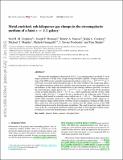Metal-enriched, subkiloparsec gas clumps in the circumgalactic medium of a faint z = 2.5 galaxy
Author(s)
Crighton, Neil H. M.; Hennawi, Joseph F.; Simcoe, Robert A.; Cooksey, Kathy L.; Murphy, Michael T.; Fumagalli, Michele; Prochaska, J. Xavier; Shanks, Tom; ... Show more Show less
DownloadSimcoe_Metal-enriched.pdf (3.257Mb)
OPEN_ACCESS_POLICY
Open Access Policy
Creative Commons Attribution-Noncommercial-Share Alike
Terms of use
Metadata
Show full item recordAbstract
We report the serendipitous detection of a 0.2 L*, Lyα emitting galaxy at redshift 2.5 at an impact parameter of 50 kpc from a bright background QSO sightline. A high-resolution spectrum of the QSO reveals a partial Lyman-limit absorption system (N[subscript Hi] = 10[superscript 16.94±0.10] cm[superscript −2]) with many associated metal absorption lines at the same redshift as the foreground galaxy. Using photoionization models that carefully treat measurement errors and marginalize over uncertainties in the shape and normalization of the ionizing radiation spectrum, we derive the total hydrogen column density N[subscript H] = 10[superscript 19.4±0.3] cm[superscript −2], and show that all the absorbing clouds are metal enriched, with Z = 0.1–0.6 Z[subscript ⊙]. These metallicities and the system's large velocity width (436 km s[superscript −1]) suggest the gas is produced by an outflowing wind. Using an expanding shell model we estimate a mass outflow rate of ~5 M[subscript ⊙] yr[superscript −1]. Our photoionization model yields extremely small sizes (<100–500 pc) for the absorbing clouds, which we argue is typical of high column density absorbers in the circumgalactic medium (CGM). Given these small sizes and extreme kinematics, it is unclear how the clumps survive in the CGM without being destroyed by hydrodynamic instabilities. The small cloud sizes imply that even state-of-the-art cosmological simulations require more than a 1000-fold improvement in mass resolution to resolve the hydrodynamics relevant for cool gas in the CGM.
Date issued
2014-11Department
Massachusetts Institute of Technology. Department of Physics; MIT Kavli Institute for Astrophysics and Space ResearchJournal
Monthly Notices of the Royal Astronomical Society
Publisher
Oxford University Press
Citation
Crighton, N. H. M., J. F. Hennawi, R. A. Simcoe, K. L. Cooksey, M. T. Murphy, M. Fumagalli, J. X. Prochaska, and T. Shanks. “Metal-Enriched, Subkiloparsec Gas Clumps in the Circumgalactic Medium of a Faint z = 2.5 Galaxy.” Monthly Notices of the Royal Astronomical Society 446, no. 1 (November 10, 2014): 18–37.
Version: Author's final manuscript
ISSN
0035-8711
1365-2966